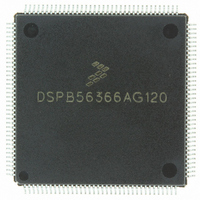DSPB56366AG120 Freescale Semiconductor, DSPB56366AG120 Datasheet - Page 12

DSPB56366AG120
Manufacturer Part Number
DSPB56366AG120
Description
IC DSP 24BIT AUD 120MHZ 144-LQFP
Manufacturer
Freescale Semiconductor
Series
Symphony™r
Type
Audio Processorr
Datasheet
1.DSPB56366AG120.pdf
(110 pages)
Specifications of DSPB56366AG120
Interface
Host Interface, I²C, SAI, SPI
Clock Rate
120MHz
Non-volatile Memory
ROM (240 kB)
On-chip Ram
69kB
Voltage - I/o
3.30V
Voltage - Core
3.30V
Operating Temperature
-40°C ~ 110°C
Mounting Type
Surface Mount
Package / Case
144-LQFP
Lead Free Status / RoHS Status
Lead free / RoHS Compliant
Available stocks
Company
Part Number
Manufacturer
Quantity
Price
Company:
Part Number:
DSPB56366AG120
Manufacturer:
TOSHIBA
Quantity:
639
Company:
Part Number:
DSPB56366AG120
Manufacturer:
FREESCAL
Quantity:
273
Company:
Part Number:
DSPB56366AG120
Manufacturer:
Freescale Semiconductor
Quantity:
10 000
2.6
The interrupt and mode control signals select the chip’s operating mode as it comes out of hardware reset.
After RESET is deasserted, these inputs are hardware interrupt request lines.
2-8
Signal Name
MODC/IRQC
MODD/IRQD
MODA/IRQA
MODB/IRQB
RESET
Interrupt and Mode Control
Type
Input
Input
Input
Input
Input
during
Reset
State
Input
Input
Input
Input
Input
Mode Select A/External Interrupt Request A—MODA/IRQA is an active-low
Schmitt-trigger input, internally synchronized to the DSP clock. MODA/IRQA selects the
initial chip operating mode during hardware reset and becomes a level-sensitive or
negative-edge-triggered, maskable interrupt request input during normal instruction
processing. MODA, MODB, MODC, and MODD select one of 16 initial chip operating
modes, latched into the OMR when the RESET signal is deasserted. If the processor is
in the stop standby state and the MODA/IRQA pin is pulled to GND, the processor will
exit the stop state.
This input is 5 V tolerant.
Mode Select B/External Interrupt Request B—MODB/IRQB is an active-low
Schmitt-trigger input, internally synchronized to the DSP clock. MODB/IRQB selects the
initial chip operating mode during hardware reset and becomes a level-sensitive or
negative-edge-triggered, maskable interrupt request input during normal instruction
processing. MODA, MODB, MODC, and MODD select one of 16 initial chip operating
modes, latched into OMR when the RESET signal is deasserted.
This input is 5 V tolerant.
Mode Select C/External Interrupt Request C—MODC/IRQC is an active-low
Schmitt-trigger input, internally synchronized to the DSP clock. MODC/IRQC selects the
initial chip operating mode during hardware reset and becomes a level-sensitive or
negative-edge-triggered, maskable interrupt request input during normal instruction
processing. MODA, MODB, MODC, and MODD select one of 16 initial chip operating
modes, latched into OMR when the RESET signal is deasserted.
This input is 5 V tolerant.
Mode Select D/External Interrupt Request D—MODD/IRQD is an active-low
Schmitt-trigger input, internally synchronized to the DSP clock. MODD/IRQD selects the
initial chip operating mode during hardware reset and becomes a level-sensitive or
negative-edge-triggered, maskable interrupt request input during normal instruction
processing. MODA, MODB, MODC, and MODD select one of 16 initial chip operating
modes, latched into OMR when the RESET signal is deasserted.
This input is 5 V tolerant.
Reset—RESET is an active-low, Schmitt-trigger input. When asserted, the chip is placed
in the Reset state and the internal phase generator is reset. The Schmitt-trigger input
allows a slowly rising input (such as a capacitor charging) to reset the chip reliably. When
the RESET signal is deasserted, the initial chip operating mode is latched from the
MODA, MODB, MODC, and MODD inputs. The RESET signal must be asserted during
power up. A stable EXTAL signal must be supplied while RESET is being asserted.
This input is 5 V tolerant.
Table 2-8 Interrupt and Mode Control
DSP56366 Technical Data, Rev. 3.1
Signal Description
Freescale Semiconductor











